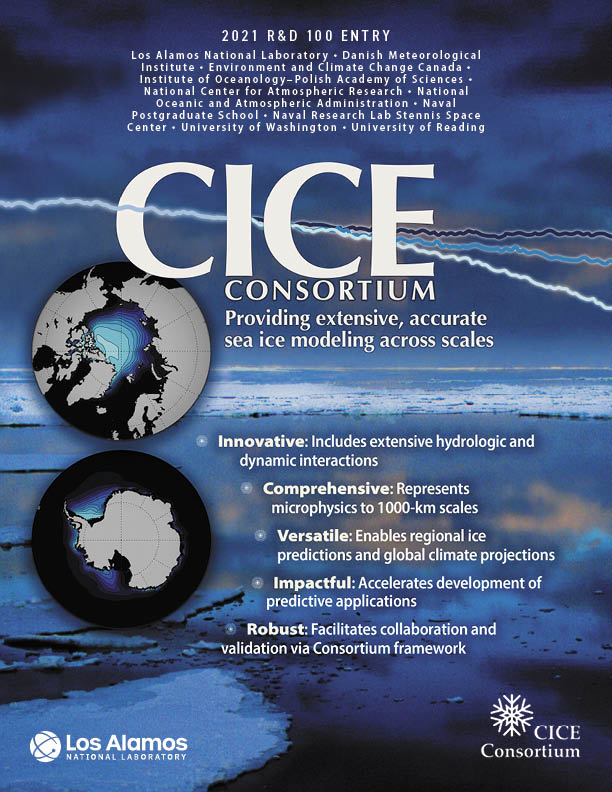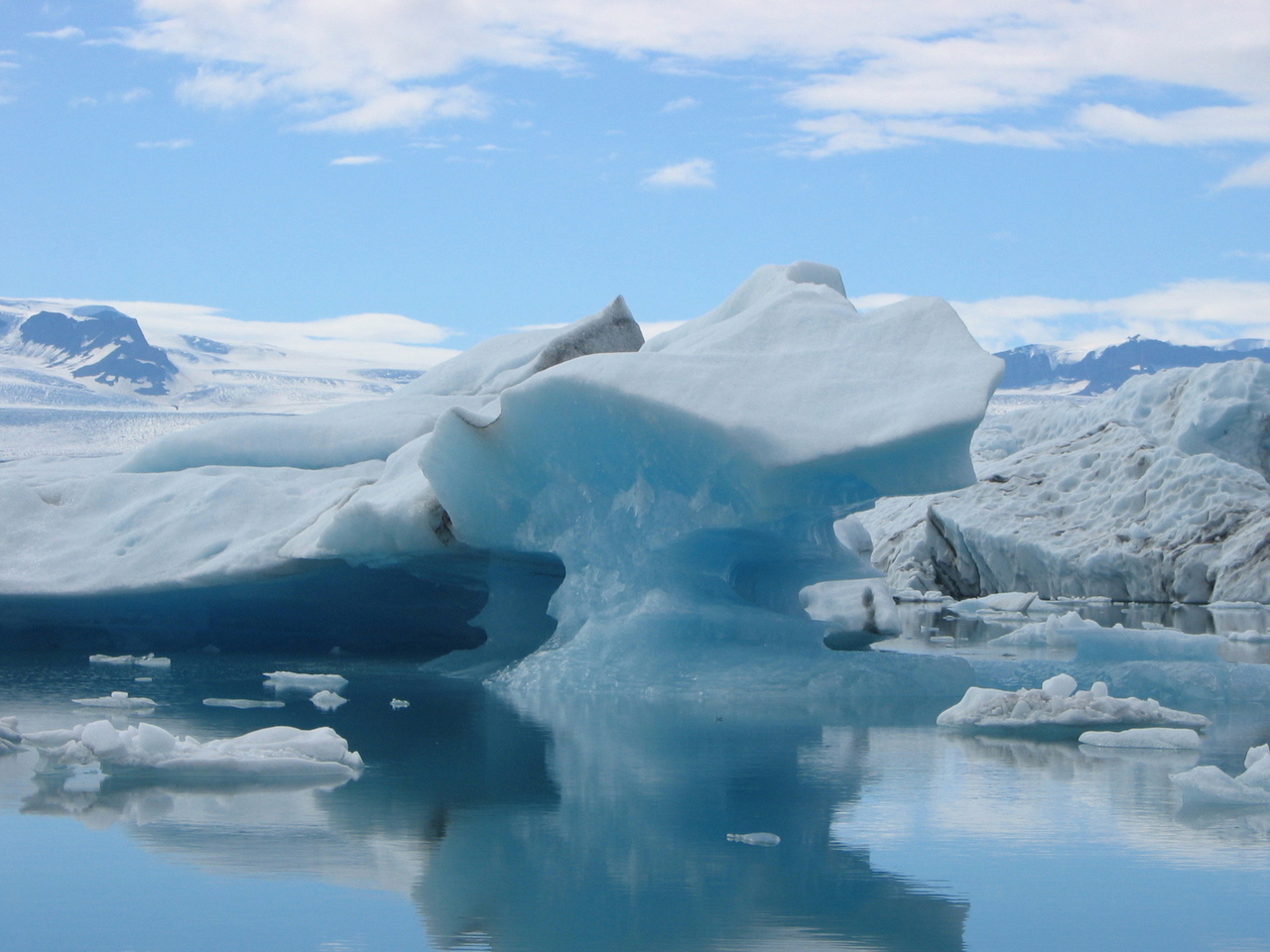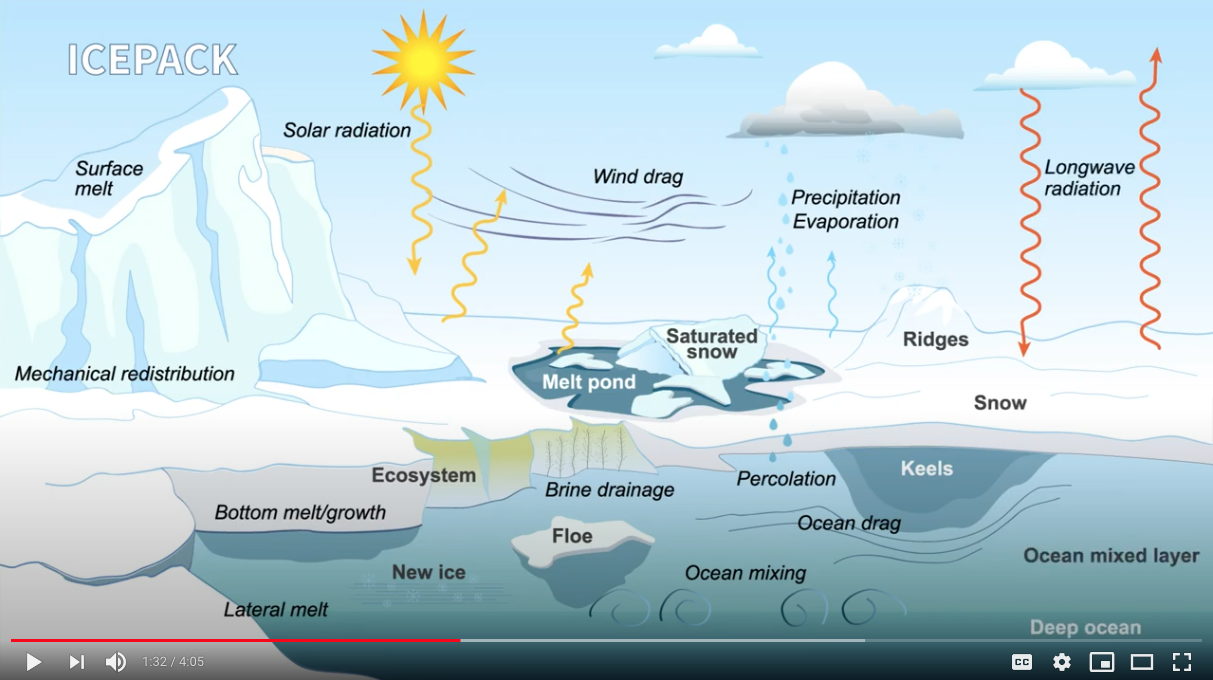CICE Consortium Won 2021 R&D 100 Award

See R&D 100: CICE video.
A complete list of winners can be found at: 2021 R&D 100 Award Winners – Research & Development World
Established in 1963, the R&D 100 Awards is the only S&T (science and technology) awards competition that recognizes new commercial products, technologies and materials for their technological significance that are available for sale or license. The R&D 100 Awards have long been a benchmark of excellence for industry sectors as diverse as telecommunications, high-energy physics, software, manufacturing, and biotechnology.
R&D100 Category: Software/Services
Developers: Los Alamos National Laboratory Los Alamos National Laboratory
Co-Developers: Danish Meteorological Institute, Environment and Climate Change Canada, Institute of Oceanology, Polish Academy of Sciences, National Center for Atmospheric Research, National Oceanic and Atmospheric Administration, Naval Postgraduate School, U. S. Naval Research Laboratory Stennis Space Center, University of Reading, University of Washington
Product Description: CICE is a computational model that represents changes to sea ice and its interactions with the polar environment and ecosystems. CICE and its support infrastructure are the global standard for sea ice modeling across scales for multiple applications, including scientific research, climate modeling, forecasting, and operations planning.

CICE is widely used for multiple applications, including modeling large-scale Earth system processes and feedbacks for both short- and long-term climate projections, research to understand the physical processes that govern environmental change, operational forecasting for lake and river ice as well as sea ice, and ecosystem impacts. CICE was originally developed for use in DOE’s climate simulations, in which a conservative, consistent, physically accurate representation of sea ice’s interactions with the ocean and atmosphere is essential. Today, CICE is the most widely used sea ice model in the Coupled Model Intercomparison Project, now in Phase 6 (CMIP6). Of the 138 CMIP6 simulation experiments carried out over the course of the project by 19 different institutions, CICE was used in 47 (34%).
With demonstrated accuracy and efficiency far superior to their sea ice models, forecasting centers have been eager to adopt it for operational uses. The Danish Meteorological Institute uses the CICE sea ice model as part of a coupled ocean-sea ice prediction system, which is driven by meteorological data from the European Centre for Medium-Range Weather Forecasts (ECMWF). Coupling CICE with ocean and atmospheric models, the U.S. Navy produces predictions of the ice then submits the output data to the National Oceanic and Atmospheric Association and to the National Ice Center. Both organizations incorporate it into their forecasts. Similarly, CICE is now being incorporated directly into the US NOAA/National Weather Service’s numerical weather prediction models in order to better capture the large-scale influences of sea ice on global weather patterns.

Photo by antoniocrp from FreeImages
Environment and Climate Change Canada uses CICE to forecast conditions in the Arctic Ocean and its marginal seas, including predictions of landfast ice, a capability that they contributed to the CICE model. Landfast ice is attached (“fastened”) to coastlines and the sea floor. The timing of when sea ice attaches to the shore and when it disintegrates affects the length of shipping, hunting and fishing seasons. Landfast ice can also block river channels, causing spring flooding. Thus, predicting the behavior of landfast sea ice can directly benefit many kinds of human activity around the polar region.
CICE offers a wide range of physics and technical options for simulating ice dynamics, rendering it uniquely capable of meeting the needs of operational forecasters as well as research scientists. The elastic-viscous-plastic (EVP) rheology first developed for CICE in the 1990s enabled more realistic sea ice simulations in global climate model runs than were previously possible, due to its highly parallel performance. EVP continues to be used extensively, including in MPAS-seaice, as it remains the most efficient approach for high quality, computationally challenging simulations. Recent improvements to the ice dynamics in CICE include an anisotropic rheology, which assumes that when the ice fractures, it does so in preferred directions. Also new in CICE is an implicit Picard solver for the original viscous-plastic rheology, and modifications to the sea ice rheology for simulating landfast ice as well as a non-normal flow rule.
Arguably, the most critical sea ice process in the climate system is thermodynamic: heat conduction through the ice and snow that determines phase changes through melting and freezing. A highly complex combination of thermal, radiative, kinematic (movement) and mechanical processes determines the composition, structure, and volume of sea ice. Heat tends to flow upward, from the warm ocean toward the colder atmosphere, resulting in strong vertical thermodynamic gradients. As such, most of the physics in sea ice models can be represented within a single grid cell (i.e., a column).
CICE’s submodule, Icepack, is a state-of-the-art sea ice column software package capable of accurately characterizing these vertical dynamics. The column physics code is executed for each grid cell or other discrete element, which enables its use in models with very different grids or meshes, such as MPAS’s unstructured meshes. As a separate module of CICE, Icepack is the only such software package available that can be easily shared with different sea ice models, enabling faster sea-ice model development and validation. E3SM incorporates an early version of Icepack in MPAS-seaice. E3SM’s improvements to the column physics are now being merged into the Icepack github repository, in preparation for upgrading to the latest version with many new community model developments, such as the floe size distribution.
Floe size distribution (FSD)— the areas covered by floes of different horizontal sizes—is analogous to the ice thickness distribution and is designed as a mathematical extension of it, from one dimension (thickness) to three dimensions (thickness and horizontal area). The FSD simulates floe sizes through the interaction of five key physical processes: new ice formation, welding of floes in freezing conditions, fracture of floes by ocean surface waves, lateral growth, and melt. The FSD allows two-way interactions between the sea ice model and an ocean surface wave model, e.g. ocean surface waves fragment sea ice, making it more susceptible to melt during the summer. In the future, ice floe size characteristics can be used to influence waves in ocean models. Floe size also influences drag and therefore affects sea ice motion.
One of DOE’s recent contributions to Icepack is a sophisticated description of the sea ice ecosystem, including different types of algae that live in the sea ice and the nutrients they feed on. The model also simulates dissolved gases that are generated in the sea ice and interact with the atmosphere and the clouds, as well as effects due to increased solar heating in biologically colored ice. Icepack’s ability to combine an advanced, multiple-scattering radiation scheme with a hydrological model (mushy thermodynamics, snow-ice formation, melt ponds) allows feedbacks to be simulated due to inclusions in the ice such as algae, aerosols, and soot. Icepack also represents the impacts and feedbacks of heat fluxes, snowpack, ponding of surface meltwater, and convergent motion on sea ice area and volume.
CICE’s supporting infrastructure (documentation, clean coding standards, open source, etc.) is a significant part of the reason for its versatility for both climate research and short-term forecasting. For example, robust testing (standard and Quality Control) engenders trust in the model’s output as do community research and validation studies in many different modeling settings. For instance, CICE utilizes hybrid parallelism via MPI and OpenMP, allowing the model to be run efficiently on diverse hardware architectures, from single processor laptops to high performance computing platforms. A recently added computational strategy involves code-specific optimization of the dynamics modules for use on newer, advanced computing architectures with accelerated processors such as Graphics Processing Units (GPU), for which communication with standard processors is limited.
The CICE development platform enables free dissemination, invites community contributions, requires rigorous code verification, and provides guidance for future improvements. The CICE Consortium’s framework promotes global collaboration, uniting research developers with operational users toward a common goal: to further scientific research and development of sea ice modeling as well as to strengthen forecasting to meet operational needs.
Working together, the research and forecasting communities continue to enrich the model’s utility and accuracy by contributing directly to model upgrades and providing validation guidance for further model development.
CICE Consortium member institutions include Los Alamos National Laboratory, the Danish Meteorological Institute, Environment and Climate Change Canada, Institute of Oceanology—Polish Academy of Sciences, National Center for Atmospheric Research, National Oceanic and Atmospheric Administration, National Aeronautics and Space Administration, and Naval Research Lab Stennis Space Center. The University of Washington, University of Reading, and Naval Postgraduate School also joined the R&D100 entry as major contributors of model developments. The Earth System Model Development Program Area (ESMD) supports DOE’s leadership of the CICE Consortium and Icepack development. The Regional and Global Model Analysis Program Area (RGMA) provides LANL Institutional Computing resources for model testing via the HiLAT project’s allocation and supports Polestar development.



